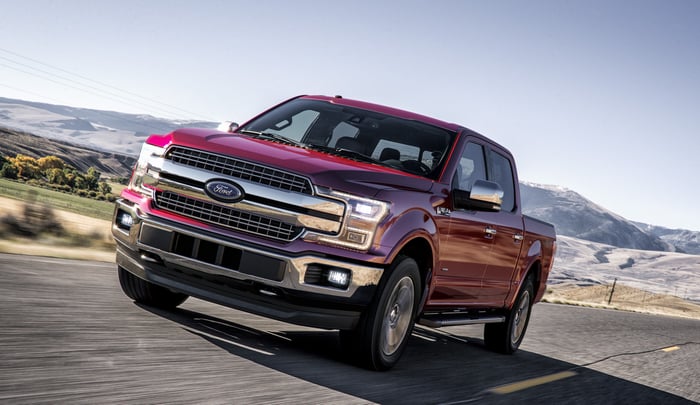Ford Motor Company (F 0.47%) said that its U.S. sales fell 6.9% in February from a year ago, as good results for its F-Series pickups weren't enough to offset big declines in sales of most Ford and Lincoln cars and SUVs.
Ford had plenty of company at the declining-sales table in February. General Motors' (GM 4.37%) sales were also down 6.9%, while Fiat Chrysler Automobiles' (FCAU) slipped 1%.
Year to date, Ford's U.S. sales are now down 6.8% -- a rough start to 2018.

Ford gave its huge-selling F-150 pickup an overhaul for 2018 to keep it fresh. It's working: Sales were up last month, while sales of both rivals fell. Image source: Ford Motor Company.
How Ford's U.S. sales stacked up against rivals in February
Here are February's sales totals for the six largest-selling automakers in the U.S. market. Of the six, only Toyota (TM 0.05%) managed a year-over-year gain, as its all-new Camry bucked the sedan-slump trend.
| Automaker | Feb. 2018 U.S. sales | Change vs. Feb. 2017 |
|---|---|---|
| General Motors | 220,905 | (6.9%) |
| Ford | 194,132 | (6.9%) |
| Toyota | 182,195 | 4.5% |
| Fiat Chrysler Automobiles | 165,903 | (1.4%) |
| Nissan | 129,930 | (4.3%) |
| Honda | 115,557 | (5%) |
Data sources: The automakers.
High and low points from Ford's February sales results
High points:
- Sales of F-Series pickups, Ford's most important profit generator, rose 3.5% in February to 68,423. That beat declines at Ford's Detroit rivals: Sales of GM's full-size pickups were down 18.6%; FCA's Ram pickups were down 15%.
- Sales of the all-new (and super-profitable) Lincoln Navigator SUV rose 13% to 1,063. Average transaction prices are up $4,600 from a year ago.
- Retail sales of the Navigator's sibling, the all-new Ford Expedition, rose 41.4%.
- "Days to turn" is the industry's measure of how long a vehicle spends on a dealer's lot before being sold. It's an indicator of demand. The industry average is around 70 days; the new Expedition is "turning" in just 13.
And the low points:
- Aside from the F-Series and the all-new big SUVs, most Ford and Lincoln models saw declines.
- Ford-brand car sales fell 10.8%. Only the Fusion (up 1.3%) posted a gain.
- Ford-brand SUV sales fell 11.8%. All models save the new EcoSport and the police version of the Explorer were down.
- Lincoln sales fell 23.4%. All Lincoln cars and SUVs aside from the Navigator were down.
The takeaway: Ford's freshest products -- the Navigator and Expedition, the F-Series Super Duty pickups, and the just-refreshed F-150 -- are still generating sales growth and commanding strong prices. Everything else, not so much.
Why Ford has been losing ground to rivals lately
Ford has been losing ground to rivals for a few months now. There appear to be two reasons for that:
- The age of (most of) Ford's product line;
- Its reluctance to boost incentives to drive sales growth.
The first point is just a fact of life: Right now, Ford is in an awkward place in its product cycle. Its entries in hot segments (compact and three-row SUVs, for example -- the Escape and Explorer) are nearing the ends of their lives, and rivals with newer products are stealing sales.
The second point is laudable from a bottom-line perspective: Holding the line on incentives helps to preserve Ford's margins. It has been Ford's policy for roughly a decade, since the days of CEO Alan Mulally, to "match production to demand," reducing supply rather than cutting prices. (That cuts both ways: Ford is increasing production of the Expedition and Navigator.)
According to figures from TrueCar subsidiary ALG, Ford was one of only two major automakers that didn't increase incentives in February. (Honda was the other.)
Buyers are still paying up for fresh new products
Across the U.S. market, it's the new products that are drawing buyers and getting strong prices. Kelley Blue Book analyst Tim Fleming said that despite slipping overall sales, pricing on fresh new products has remained strong -- even in weak market segments:
The numbers indicate that new-car buyers are still willing to pay top dollar for the latest models with the most current features and technology. Even the new Honda Accord and Toyota Camry are commanding large premiums over their predecessors, despite competing in a rapidly shrinking segment.
The takeaway for Ford investors: Ford may be suffering more than some rivals because of the relative age of most of its product line -- but broadly speaking, its results mirror the overall industry's trends at this stage in the market cycle.





